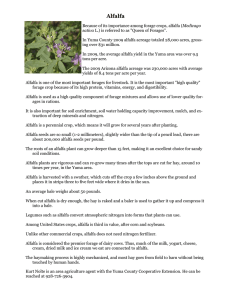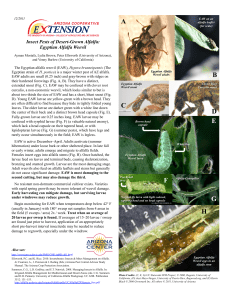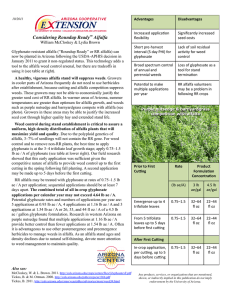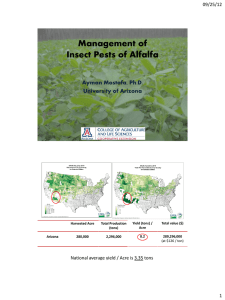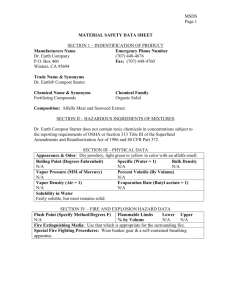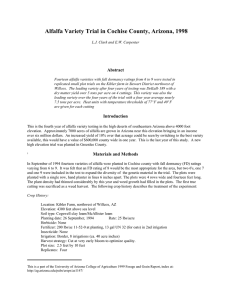Effect of Late Winter 1998 Furadan4F Alfalfa
advertisement
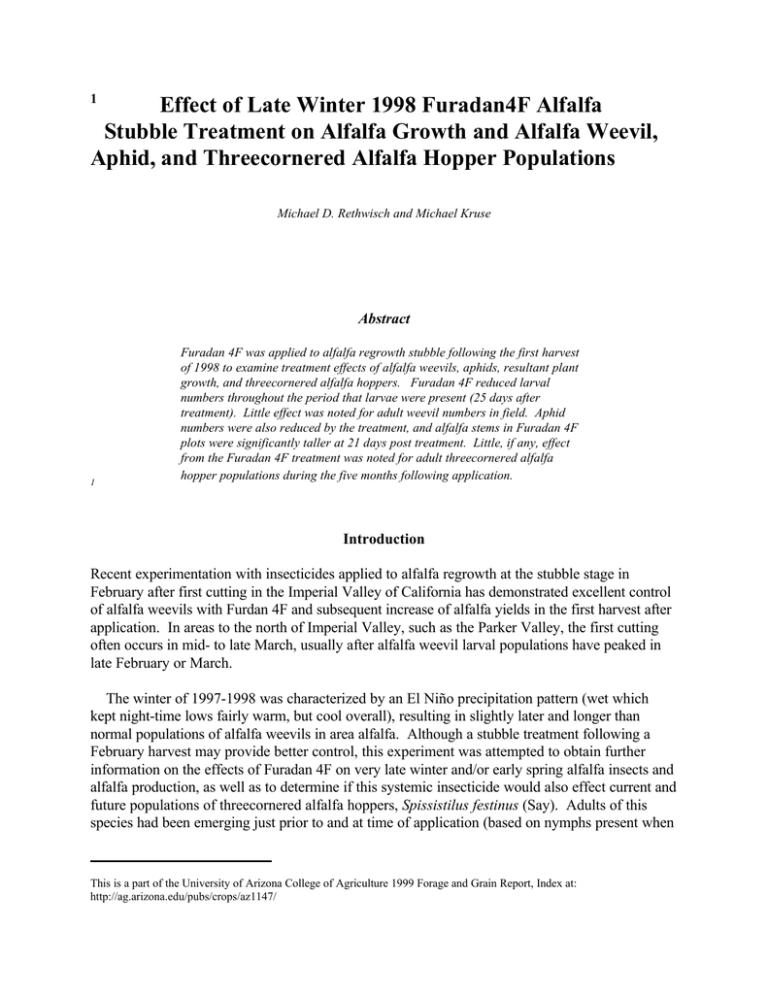
1 Effect of Late Winter 1998 Furadan4F Alfalfa Stubble Treatment on Alfalfa Growth and Alfalfa Weevil, Aphid, and Threecornered Alfalfa Hopper Populations Michael D. Rethwisch and Michael Kruse Abstract 1 Furadan 4F was applied to alfalfa regrowth stubble following the first harvest of 1998 to examine treatment effects of alfalfa weevils, aphids, resultant plant growth, and threecornered alfalfa hoppers. Furadan 4F reduced larval numbers throughout the period that larvae were present (25 days after treatment). Little effect was noted for adult weevil numbers in field. Aphid numbers were also reduced by the treatment, and alfalfa stems in Furadan 4F plots were significantly taller at 21 days post treatment. Little, if any, effect from the Furadan 4F treatment was noted for adult threecornered alfalfa hopper populations during the five months following application. Introduction Recent experimentation with insecticides applied to alfalfa regrowth at the stubble stage in February after first cutting in the Imperial Valley of California has demonstrated excellent control of alfalfa weevils with Furdan 4F and subsequent increase of alfalfa yields in the first harvest after application. In areas to the north of Imperial Valley, such as the Parker Valley, the first cutting often occurs in mid- to late March, usually after alfalfa weevil larval populations have peaked in late February or March. The winter of 1997-1998 was characterized by an El Niño precipitation pattern (wet which kept night-time lows fairly warm, but cool overall), resulting in slightly later and longer than normal populations of alfalfa weevils in area alfalfa. Although a stubble treatment following a February harvest may provide better control, this experiment was attempted to obtain further information on the effects of Furadan 4F on very late winter and/or early spring alfalfa insects and alfalfa production, as well as to determine if this systemic insecticide would also effect current and future populations of threecornered alfalfa hoppers, Spissistilus festinus (Say). Adults of this species had been emerging just prior to and at time of application (based on nymphs present when This is a part of the University of Arizona College of Agriculture 1999 Forage and Grain Report, Index at: http://ag.arizona.edu/pubs/crops/az1147/ utilizing sweep net sampling in late February and early March) and nymphs were also thought to be feeding on alfalfa roots/crowns just at or below the soil surface. Methods and Materials An alfalfa field in its third year of production (variety = CUF 101) located on the Colorado River Indian Tribes Reservation near Parker, AZ, was used for this experiment. Plots were treated on March 13, 1998 following the first cutting (stubble height). Furadan 4F (active ingredient = carbofuran) was applied by air (John Kamburoff Aerial Spray, Inc., Poston, AZ) at a rate of one quart (1.0 lbs. active ingredient) per acre in a finished spray of 5 gallons per acre. Treated and untreated plots sizes were 140 wide by field length (574 ft) with the exception of the furthest west untreated plot, which was located on the field edge and was only 24 ft wide. Treatments were replicated three times in a complete block design. Insect numbers were obtained via sweep net sampling taken twice a week when alfalfa was tall enough to sweep with a 15 inch diameter sweep net begining March 23 and continued through August 27. Sampling for insects continued weekly beginning in September through early October when the field was disced. Sampling consisted of ten to forty 90o sweeps/plot taken near the longitudinal center line of each plot to avoid potential interplot insect dispersion, and counting and recording insect numbers (alfalfa weevil larvae and/or adults through first cutting after application, threecornered alfalfa hoppers (3CAH) throughout study duration). The field was harvested April 20, June 11, July 6 and 30, and August 24-25. Regrowth shortly after these dates was often too short to adequately sample and/or was being irrigated, making sampling difficult. Plant heights were obtained on April 3 (21 days post treatment) by measuring and recording the height (in inches) of 25 plants per plot. Aphids (blue alfalfa aphid, Acyrthosipon kondoi Shinji, and pea aphid, A. pisum Harris) were also prevalent at that time. Aphids were not counted or separated to species, but aphid volume was determined by placing aphids obtained from twenty 90o sweeps in a 100 ml graduated cylinder. Data were statistically analyzed using an S-N-K test. Results Alfalfa Weevils Furadan 4F provided excellent control of alfalfa weevil larvae in the four week period after application. Although numbers of larvae were below economic levels during the study, significant differences were noted in the larval peaks at 17 days post treatment in both treated and untreated plots (Table 1). No larvae were collected in samples from the Furadan plots prior to this sampling date, although they were present in samples from untreated plots. No larvae were noted in samples after April 7 (25 days post treatment). Alfalfa weevils adults were not detected in samples from plots until 14 days post treatment (March 27). No significant differences were noted for mean numbers of adult alfalfa weevils in this experiment (Table 1). Aphids and Plant Height Aphid numbers remained fairly low during the first few weeks of the study. Mean aphid amounts (volume based), were still reduced by almost 50% by the Furadan treatment at 21 days post treatment (Table 2). A highly significant difference was also noted in alfalfa height at this time. Although the height increase associated with the Furadan treatment may be primarily due to aphid control, it could also be a function and combination of the Furadan treatment itself interacting with the alfalfa and promoting growth as Furadan is known to have a growth stimulant response, referred to as a 'carbamate kick', with certain crops. This increased growth usually means increased tonnage, although the quality may be slightly higher in plots where aphids have not been controlled. Attempts to obtain yields and quality from the plots in the harvest immediately after application were not successful. Threecornered Alfalfa Hoppers No significant differences existed between adult three- cornered alfalfa hopper (3CAH) populations when comparing the treated and untreated plots for any sample date, indicating that a March 13 application of Furadan 4F had little effect on subsequent adult 3CAH populations. The greatest populations of adult 3CAH were usually found in the narrow (24 ft wide) untreated plot at the edge of the field, with 3CAH numbers often (although not consistently) 2-5x higher than any other plots in the field. This may indicate that 3CAH were utilizing the field edge for feeding and perhaps migrating into this area from an adjacent field when harvested and/or from adjacent vegetation as it dried during the summer as alfalfa may have been a more succulent host plant, or that 3CAH establishment in the field was greatest along field edges. Other field edges were not sampled to determine if this edge effect was evident throughout the field. Seasonal population of this insect during the study in shown in Figure 1. As significant differences were not noted between treatments, overall 3CAH average is shown. The narrow (24 ft.) plot at field margin was not included in the averages shown due to high fluctuations that may not have been indicative of population dynamics for the overall field and may have provided misleading information. Populations of adult 3CAH decreased in late March and were not detected in early April. Low numbers/sweep were noted again beginning April 10 through the end of April, and began to increase during the summer cuttings, with highest populations noted just prior to the August 25 cutting. Numbers immediately following this cutting were the highest after any cutting during the study of the duration, suggesting that higher populations of 3CAH would be expected in September than any noted between late March and late August. Numbers of adult 3CAH generally increased throughout the cutting cycle and decreased immediately after a cutting. Two exceptions to this appear to be adult peaks between cuttings on May 31 and June 29. Acknowledgements The cooperation of Phileo Farms (Bob Talley - grower) and Danny Hensley (P.C.A. - Dune Co.) is greatly appreciated. This study was funded in part by FMC Corporation. TABLE 1. Mean number/sweep of alfalfa weevil larvae and adults following application of Furadan 4F on March 13, 1999, at the rate of one quart/acre. Larvae Days after Treatment 10 14 17 21 25 28 Furadan 4F 0.00a 0.00a 0.05 b 0.017a 0.00a 0.00a Untreated 0.283a 0.45a 0.80a 0.083a 0.017a 0.00a Adults Days after Treatment 10 14 17 21 25 28 Furadan 4F 0.00a 0.00a 0.20a 0.167a 0.083a 0.083a Untreated 0.00a 0.083a 0.10a 0.20a 0.067a 0.033a Means in sub-columns followed by the same letter are not significantly different at the P<0.05 level (S-N-K test). Table 2. Means of plant heights (inches) and volume of aphids on April 3 (21 days post treatment). Plant height ml of aphids Furadan 4F 21.1a 4.5a Untreated 19.8 b 8.0a Means in columns followed by the same letter are not significantly different at the P<0.01 level (S-N-K test).


